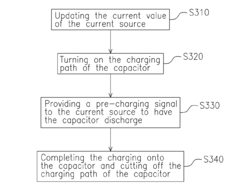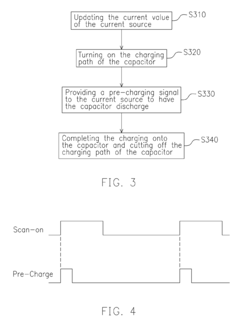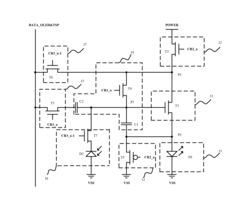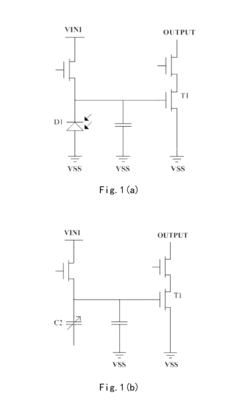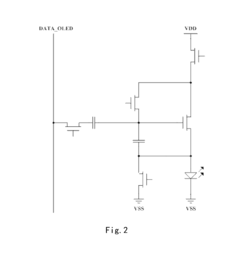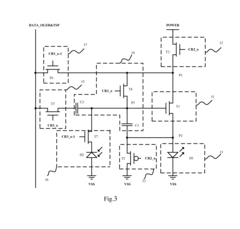Exploration of bistable AMOLED displays for static content applications.
JUL 17, 20259 MIN READ
Generate Your Research Report Instantly with AI Agent
Patsnap Eureka helps you evaluate technical feasibility & market potential.
AMOLED Bistable Tech Evolution
The evolution of AMOLED bistable technology for static content applications has been marked by significant advancements in display technology over the past decade. Initially, AMOLED displays were primarily used for dynamic content due to their superior color reproduction and high refresh rates. However, the concept of bistable AMOLED displays emerged as a solution to address the power consumption issues associated with static content display.
The first generation of bistable AMOLED displays focused on implementing basic pixel memory capabilities. These early designs utilized a combination of OLED materials and thin-film transistors (TFTs) to create pixels that could maintain their state without continuous power input. This approach significantly reduced power consumption for static images but faced challenges in terms of image retention and color accuracy.
As the technology progressed, researchers developed more sophisticated bistable pixel architectures. The second generation introduced advanced charge trapping mechanisms within the OLED stack, allowing for longer-lasting image retention without compromising display quality. This iteration also saw improvements in addressing schemes, enabling more efficient switching between bistable and dynamic modes.
The third generation of bistable AMOLED technology brought about a paradigm shift with the integration of nanomaterials. Quantum dots and other nanostructures were incorporated into the OLED layers, enhancing both the bistable properties and the overall display performance. This innovation led to improved color gamut, higher contrast ratios, and more energy-efficient state transitions.
Recent developments have focused on hybrid approaches, combining the benefits of bistable AMOLED technology with other display technologies. For instance, the integration of e-paper-like materials within the OLED structure has resulted in displays that can switch between high-refresh-rate dynamic content and ultra-low-power static content modes seamlessly.
The latest advancements in bistable AMOLED technology have centered around enhancing the longevity and reliability of the bistable state. Researchers have developed novel pixel designs that can maintain static images for extended periods without degradation, addressing concerns about image burn-in and color shift over time.
Looking ahead, the evolution of bistable AMOLED technology is expected to continue with a focus on further reducing power consumption, improving color accuracy in bistable mode, and expanding the range of applications. Emerging trends include the development of flexible and stretchable bistable AMOLED displays, as well as the integration of advanced AI algorithms for optimizing display modes based on content and user behavior.
The first generation of bistable AMOLED displays focused on implementing basic pixel memory capabilities. These early designs utilized a combination of OLED materials and thin-film transistors (TFTs) to create pixels that could maintain their state without continuous power input. This approach significantly reduced power consumption for static images but faced challenges in terms of image retention and color accuracy.
As the technology progressed, researchers developed more sophisticated bistable pixel architectures. The second generation introduced advanced charge trapping mechanisms within the OLED stack, allowing for longer-lasting image retention without compromising display quality. This iteration also saw improvements in addressing schemes, enabling more efficient switching between bistable and dynamic modes.
The third generation of bistable AMOLED technology brought about a paradigm shift with the integration of nanomaterials. Quantum dots and other nanostructures were incorporated into the OLED layers, enhancing both the bistable properties and the overall display performance. This innovation led to improved color gamut, higher contrast ratios, and more energy-efficient state transitions.
Recent developments have focused on hybrid approaches, combining the benefits of bistable AMOLED technology with other display technologies. For instance, the integration of e-paper-like materials within the OLED structure has resulted in displays that can switch between high-refresh-rate dynamic content and ultra-low-power static content modes seamlessly.
The latest advancements in bistable AMOLED technology have centered around enhancing the longevity and reliability of the bistable state. Researchers have developed novel pixel designs that can maintain static images for extended periods without degradation, addressing concerns about image burn-in and color shift over time.
Looking ahead, the evolution of bistable AMOLED technology is expected to continue with a focus on further reducing power consumption, improving color accuracy in bistable mode, and expanding the range of applications. Emerging trends include the development of flexible and stretchable bistable AMOLED displays, as well as the integration of advanced AI algorithms for optimizing display modes based on content and user behavior.
Static Content Display Market
The static content display market has witnessed significant growth in recent years, driven by the increasing demand for energy-efficient and visually appealing display solutions across various industries. This market segment primarily caters to applications where information remains unchanged for extended periods, such as digital signage, e-readers, electronic shelf labels, and smart home devices.
The global static content display market is experiencing robust expansion, with a compound annual growth rate (CAGR) projected to remain strong over the next five years. This growth is attributed to the rising adoption of digital signage in retail, transportation, and healthcare sectors, as well as the growing popularity of e-paper displays in consumer electronics.
One of the key drivers of market demand is the increasing focus on energy efficiency and sustainability. Static content displays, particularly those utilizing bistable technologies, offer significant power savings compared to traditional dynamic displays. This aligns well with the global push for green technologies and reduced energy consumption in electronic devices.
The retail sector represents a substantial portion of the static content display market, with electronic shelf labels (ESLs) gaining traction due to their ability to streamline pricing updates and improve operational efficiency. The healthcare industry is another significant contributor, utilizing static displays for patient information systems and wayfinding solutions in hospitals and clinics.
In the consumer electronics segment, e-readers continue to maintain a steady market presence, appealing to avid readers who prefer the eye-friendly nature of e-paper displays. Additionally, the smart home market is emerging as a promising avenue for static content displays, with applications in energy management systems, home automation controls, and information panels.
Geographically, North America and Europe lead the static content display market, owing to early adoption of digital signage technologies and stringent energy efficiency regulations. However, the Asia-Pacific region is expected to witness the fastest growth, driven by rapid digitalization in emerging economies and increasing investments in smart city initiatives.
The market landscape is characterized by a mix of established players and innovative startups. Key market participants are focusing on developing advanced display technologies that offer improved visual quality, faster refresh rates, and enhanced energy efficiency. Collaborations between display manufacturers and content management software providers are becoming increasingly common, aiming to deliver comprehensive solutions to end-users.
As the demand for static content displays continues to grow, the market is likely to see further innovations in display technologies, particularly in the realm of bistable AMOLED displays. These advancements are expected to open up new application areas and drive market expansion in the coming years.
The global static content display market is experiencing robust expansion, with a compound annual growth rate (CAGR) projected to remain strong over the next five years. This growth is attributed to the rising adoption of digital signage in retail, transportation, and healthcare sectors, as well as the growing popularity of e-paper displays in consumer electronics.
One of the key drivers of market demand is the increasing focus on energy efficiency and sustainability. Static content displays, particularly those utilizing bistable technologies, offer significant power savings compared to traditional dynamic displays. This aligns well with the global push for green technologies and reduced energy consumption in electronic devices.
The retail sector represents a substantial portion of the static content display market, with electronic shelf labels (ESLs) gaining traction due to their ability to streamline pricing updates and improve operational efficiency. The healthcare industry is another significant contributor, utilizing static displays for patient information systems and wayfinding solutions in hospitals and clinics.
In the consumer electronics segment, e-readers continue to maintain a steady market presence, appealing to avid readers who prefer the eye-friendly nature of e-paper displays. Additionally, the smart home market is emerging as a promising avenue for static content displays, with applications in energy management systems, home automation controls, and information panels.
Geographically, North America and Europe lead the static content display market, owing to early adoption of digital signage technologies and stringent energy efficiency regulations. However, the Asia-Pacific region is expected to witness the fastest growth, driven by rapid digitalization in emerging economies and increasing investments in smart city initiatives.
The market landscape is characterized by a mix of established players and innovative startups. Key market participants are focusing on developing advanced display technologies that offer improved visual quality, faster refresh rates, and enhanced energy efficiency. Collaborations between display manufacturers and content management software providers are becoming increasingly common, aiming to deliver comprehensive solutions to end-users.
As the demand for static content displays continues to grow, the market is likely to see further innovations in display technologies, particularly in the realm of bistable AMOLED displays. These advancements are expected to open up new application areas and drive market expansion in the coming years.
Bistable AMOLED Challenges
The development of bistable AMOLED displays for static content applications faces several significant challenges that need to be addressed. One of the primary obstacles is achieving long-term image retention without compromising display quality. Unlike traditional AMOLED displays, bistable AMOLEDs must maintain a stable image for extended periods without continuous power input, which poses unique material and design challenges.
A major hurdle in this field is the development of organic materials that can maintain two distinct, stable states for prolonged durations. These materials need to switch between states rapidly when triggered but remain unchanged in the absence of stimuli. Finding the right balance between stability and switchability is a complex task that requires extensive research in organic chemistry and materials science.
Another significant challenge lies in the pixel architecture design. Conventional AMOLED pixels are optimized for frequent updates, whereas bistable displays need a modified structure that can hold charge and maintain pixel states over time. This necessitates rethinking the thin-film transistor (TFT) backplane design and potentially incorporating additional components for state maintenance.
Power management presents another set of challenges. While bistable AMOLEDs promise lower power consumption for static content, they still require energy for state switching and periodic refreshes to prevent image degradation. Developing efficient power delivery systems and optimizing refresh cycles are crucial for maximizing the energy-saving potential of these displays.
Addressing image quality concerns is also paramount. Bistable AMOLEDs must maintain color accuracy, brightness, and contrast over time, even as the display remains in a static state. This requires innovative approaches to color calibration and compensation techniques to counteract any drift or degradation in the organic materials.
Manufacturing scalability poses yet another challenge. The production processes for bistable AMOLEDs may differ significantly from those of conventional AMOLEDs, potentially requiring new equipment and techniques. Ensuring consistent quality and yield rates at scale will be critical for commercial viability.
Lastly, integrating bistable AMOLEDs into existing device ecosystems presents both hardware and software challenges. Display drivers and operating systems need to be adapted to support the unique characteristics of bistable displays, including optimized refresh strategies and power management protocols. This requires collaboration across the supply chain and may necessitate the development of new industry standards.
A major hurdle in this field is the development of organic materials that can maintain two distinct, stable states for prolonged durations. These materials need to switch between states rapidly when triggered but remain unchanged in the absence of stimuli. Finding the right balance between stability and switchability is a complex task that requires extensive research in organic chemistry and materials science.
Another significant challenge lies in the pixel architecture design. Conventional AMOLED pixels are optimized for frequent updates, whereas bistable displays need a modified structure that can hold charge and maintain pixel states over time. This necessitates rethinking the thin-film transistor (TFT) backplane design and potentially incorporating additional components for state maintenance.
Power management presents another set of challenges. While bistable AMOLEDs promise lower power consumption for static content, they still require energy for state switching and periodic refreshes to prevent image degradation. Developing efficient power delivery systems and optimizing refresh cycles are crucial for maximizing the energy-saving potential of these displays.
Addressing image quality concerns is also paramount. Bistable AMOLEDs must maintain color accuracy, brightness, and contrast over time, even as the display remains in a static state. This requires innovative approaches to color calibration and compensation techniques to counteract any drift or degradation in the organic materials.
Manufacturing scalability poses yet another challenge. The production processes for bistable AMOLEDs may differ significantly from those of conventional AMOLEDs, potentially requiring new equipment and techniques. Ensuring consistent quality and yield rates at scale will be critical for commercial viability.
Lastly, integrating bistable AMOLEDs into existing device ecosystems presents both hardware and software challenges. Display drivers and operating systems need to be adapted to support the unique characteristics of bistable displays, including optimized refresh strategies and power management protocols. This requires collaboration across the supply chain and may necessitate the development of new industry standards.
Current Bistable AMOLED Solutions
01 Pixel circuit design for stability
Improved pixel circuit designs are implemented to enhance the stability of bistable AMOLED displays. These designs focus on compensating for voltage threshold shifts and reducing current variations in the driving transistors, resulting in more consistent and stable display performance over time.- Pixel circuit design for stability: Improved pixel circuit designs are implemented to enhance the stability of bistable AMOLED displays. These designs focus on reducing voltage fluctuations, minimizing current leakage, and maintaining consistent pixel states over time. Advanced compensation techniques are incorporated to address issues such as threshold voltage shifts and mobility variations in thin-film transistors.
- Material selection for enhanced stability: Careful selection and optimization of materials used in bistable AMOLED displays contribute to improved stability. This includes the development of more stable organic light-emitting materials, robust electrode materials, and enhanced encapsulation techniques to protect sensitive components from environmental factors such as moisture and oxygen.
- Driving scheme optimization: Advanced driving schemes are developed to maintain the stability of bistable AMOLED displays. These schemes include optimized voltage and current control methods, improved refresh rates, and intelligent power management techniques. The goal is to minimize stress on display components while ensuring consistent image quality and reducing power consumption.
- Thermal management for stability: Effective thermal management strategies are implemented to enhance the stability of bistable AMOLED displays. These include advanced heat dissipation techniques, temperature-compensated driving methods, and the integration of thermal sensors for real-time monitoring and adjustment. Proper thermal management helps prevent degradation of organic materials and maintains consistent display performance.
- Compensation algorithms and circuits: Sophisticated compensation algorithms and circuits are developed to address various factors affecting the stability of bistable AMOLED displays. These include techniques for compensating aging effects, non-uniformity correction, and adaptive brightness control. Implementation of these algorithms helps maintain consistent image quality and extends the overall lifespan of the display.
02 Compensation techniques for display uniformity
Various compensation techniques are employed to improve display uniformity and stability. These include methods for sensing and adjusting pixel voltages, implementing feedback loops, and utilizing advanced algorithms to correct for variations in pixel performance across the display.Expand Specific Solutions03 Material innovations for AMOLED stability
Novel materials and structures are developed to enhance the stability of AMOLED displays. These innovations include improved organic light-emitting materials, more robust thin-film transistor designs, and advanced encapsulation techniques to protect against environmental factors that can degrade display performance.Expand Specific Solutions04 Driving schemes for bistable operation
Specialized driving schemes are implemented to achieve stable bistable operation in AMOLED displays. These methods focus on optimizing voltage and current control during pixel switching, minimizing power consumption, and maintaining image retention in low-power states.Expand Specific Solutions05 Thermal management for long-term stability
Thermal management techniques are employed to ensure long-term stability of bistable AMOLED displays. These approaches include improved heat dissipation designs, temperature-compensated driving circuits, and adaptive brightness control to minimize thermal stress on display components.Expand Specific Solutions
Key AMOLED Display Manufacturers
The exploration of bistable AMOLED displays for static content applications is in an emerging phase, with the market showing significant growth potential. The technology's maturity is advancing rapidly, driven by key players like BOE Technology Group, E Ink Corp., and Merck Patent GmbH. These companies are at the forefront of developing innovative solutions, leveraging their expertise in display technologies and materials science. The market size is expanding as the demand for energy-efficient, high-contrast displays in e-readers, digital signage, and smart wearables increases. While not yet mainstream, bistable AMOLED technology is gaining traction due to its low power consumption and improved readability in various lighting conditions, positioning it as a promising alternative to traditional display technologies.
E Ink Corp.
Technical Solution: E Ink Corporation has pioneered the development of electrophoretic display technology, which forms the basis of their approach to bistable displays for static content applications. While not strictly AMOLED, their technology shares the goal of low power consumption for static images. E Ink's displays use millions of tiny microcapsules, each containing positively charged white particles and negatively charged black particles suspended in a clear fluid[4]. When an electric field is applied, the particles move to the top or bottom of the microcapsule, making the surface appear white or black at that spot. This creates a paper-like display that only consumes power when the image changes[5]. E Ink has recently been exploring hybrid technologies that combine their electrophoretic displays with OLED elements for improved color rendition and video capabilities while maintaining low power consumption for static content[6].
Strengths: Extremely low power consumption, high readability in bright light, and paper-like appearance. Weaknesses: Limited color capabilities and slower refresh rates compared to traditional displays.
Merck Patent GmbH
Technical Solution: Merck Patent GmbH has been actively researching and developing materials for bistable AMOLED displays. Their approach focuses on creating novel organic semiconductors and liquid crystal materials that can maintain stable states with minimal energy input. Merck has developed proprietary reactive mesogens that can be polymerized to form a stable network within the OLED structure, contributing to the bistability of the display[7]. These materials allow for the creation of displays that can maintain an image without continuous power supply, making them suitable for static content applications. Merck's research also extends to the development of advanced electrode materials and charge transport layers that enhance the stability and efficiency of bistable AMOLED displays[8]. Their materials have been designed to be compatible with existing AMOLED manufacturing processes, facilitating easier adoption by display manufacturers[9].
Strengths: Cutting-edge material science, compatibility with existing manufacturing processes, and potential for high-performance bistable displays. Weaknesses: Reliance on partnerships with display manufacturers for implementation and potential for higher material costs.
Bistable AMOLED Core Patents
Method for driving a current-driven active matrix organic light emitting diode pixel
PatentInactiveUS7429969B2
Innovation
- A method is introduced where a pre-charging signal is provided to the driving current source before data update to discharge the capacitor via a discharging path, ensuring proper voltage discharge and maintaining display consistency across frames.
Active matrix organic light emitting diode pixel unit circuit and display panel
PatentActiveUS9530354B2
Innovation
- An active matrix organic light emitting diode pixel unit circuit is designed with specific modules such as a light emitting module, driving module, threshold compensation module, light emitting control module, touch sensing module, and sensing signal output module, utilizing common data lines and control signals to integrate the TSP in Cell circuit, including additional TFTs and capacitors, while optimizing circuit components and signal operations.
Power Efficiency in Static Displays
Power efficiency is a critical factor in the development and adoption of bistable AMOLED displays for static content applications. These displays offer significant advantages in terms of energy consumption, particularly for devices that frequently display static images or text for extended periods.
Bistable AMOLED technology leverages the inherent stability of certain organic materials to maintain a display state without continuous power input. This characteristic allows for substantial power savings compared to traditional AMOLED displays, which require constant refreshing to maintain an image.
In static display scenarios, such as e-readers, digital signage, or smartwatch always-on displays, bistable AMOLEDs can reduce power consumption by up to 90% compared to conventional display technologies. This efficiency is achieved through the elimination of constant pixel refreshing, as the display only consumes power when the content changes.
The power efficiency of bistable AMOLED displays is further enhanced by their ability to operate in a reflective mode under bright ambient light conditions. This feature reduces the need for backlighting, which is a significant power drain in traditional displays. By utilizing ambient light, these displays can maintain visibility while consuming minimal power, making them ideal for outdoor applications and wearable devices.
Another key aspect of power efficiency in bistable AMOLED displays is their rapid switching capability. The transition between display states occurs quickly and with minimal energy expenditure, allowing for responsive user interfaces without compromising battery life. This characteristic is particularly valuable in devices that require frequent updates to small portions of the screen, such as smartwatches displaying time or notifications.
The development of low-power driving circuits and optimized pixel architectures has further contributed to the overall energy efficiency of bistable AMOLED displays. These advancements have reduced the power required for both state transitions and maintenance of static images, extending battery life in portable devices and reducing operational costs for large-scale installations.
As research in this field progresses, we can expect to see further improvements in power efficiency through the development of new organic materials with enhanced bistable properties and more sophisticated power management algorithms. These advancements will likely expand the application range of bistable AMOLED technology, making it a compelling choice for a wider variety of devices and use cases where power efficiency is paramount.
Bistable AMOLED technology leverages the inherent stability of certain organic materials to maintain a display state without continuous power input. This characteristic allows for substantial power savings compared to traditional AMOLED displays, which require constant refreshing to maintain an image.
In static display scenarios, such as e-readers, digital signage, or smartwatch always-on displays, bistable AMOLEDs can reduce power consumption by up to 90% compared to conventional display technologies. This efficiency is achieved through the elimination of constant pixel refreshing, as the display only consumes power when the content changes.
The power efficiency of bistable AMOLED displays is further enhanced by their ability to operate in a reflective mode under bright ambient light conditions. This feature reduces the need for backlighting, which is a significant power drain in traditional displays. By utilizing ambient light, these displays can maintain visibility while consuming minimal power, making them ideal for outdoor applications and wearable devices.
Another key aspect of power efficiency in bistable AMOLED displays is their rapid switching capability. The transition between display states occurs quickly and with minimal energy expenditure, allowing for responsive user interfaces without compromising battery life. This characteristic is particularly valuable in devices that require frequent updates to small portions of the screen, such as smartwatches displaying time or notifications.
The development of low-power driving circuits and optimized pixel architectures has further contributed to the overall energy efficiency of bistable AMOLED displays. These advancements have reduced the power required for both state transitions and maintenance of static images, extending battery life in portable devices and reducing operational costs for large-scale installations.
As research in this field progresses, we can expect to see further improvements in power efficiency through the development of new organic materials with enhanced bistable properties and more sophisticated power management algorithms. These advancements will likely expand the application range of bistable AMOLED technology, making it a compelling choice for a wider variety of devices and use cases where power efficiency is paramount.
Bistable AMOLED Reliability
The reliability of bistable AMOLED displays is a critical factor in their adoption for static content applications. These displays offer significant power-saving advantages, but their long-term stability and performance consistency are areas of ongoing research and development.
One of the primary reliability concerns for bistable AMOLEDs is the potential for image retention or burn-in. Unlike traditional AMOLED displays, bistable variants are designed to maintain a static image without continuous power input. However, this prolonged display of static content can lead to uneven aging of the organic materials, potentially resulting in ghosting effects or permanent image retention over time.
Another key reliability aspect is the stability of the bistable state itself. The display must consistently maintain the desired image without degradation or unintended state changes. This requires careful engineering of the organic materials and pixel structures to ensure that the bistable mechanism remains robust over thousands of switching cycles and extended periods of static display.
Environmental factors also play a significant role in the reliability of bistable AMOLED displays. Temperature fluctuations, humidity, and exposure to UV light can all impact the performance and longevity of the organic materials. Manufacturers must develop robust encapsulation techniques and implement temperature compensation mechanisms to maintain display quality across a wide range of operating conditions.
The power-switching components used to toggle between bistable states are another critical reliability consideration. These components must operate consistently over the device's lifetime, with minimal degradation in switching speed or efficiency. Failure of these components could lead to incomplete state changes or increased power consumption, negating the energy-saving benefits of the bistable design.
Long-term color stability is an additional challenge for bistable AMOLED displays. The organic materials used for different color subpixels may age at different rates, potentially leading to color shifts over time. This is particularly noticeable in static content applications where the same image is displayed for extended periods.
To address these reliability concerns, manufacturers are investing in advanced materials research, improved pixel architectures, and sophisticated compensation algorithms. These efforts aim to extend the operational lifespan of bistable AMOLED displays, ensuring consistent performance and image quality throughout the device's intended use period.
One of the primary reliability concerns for bistable AMOLEDs is the potential for image retention or burn-in. Unlike traditional AMOLED displays, bistable variants are designed to maintain a static image without continuous power input. However, this prolonged display of static content can lead to uneven aging of the organic materials, potentially resulting in ghosting effects or permanent image retention over time.
Another key reliability aspect is the stability of the bistable state itself. The display must consistently maintain the desired image without degradation or unintended state changes. This requires careful engineering of the organic materials and pixel structures to ensure that the bistable mechanism remains robust over thousands of switching cycles and extended periods of static display.
Environmental factors also play a significant role in the reliability of bistable AMOLED displays. Temperature fluctuations, humidity, and exposure to UV light can all impact the performance and longevity of the organic materials. Manufacturers must develop robust encapsulation techniques and implement temperature compensation mechanisms to maintain display quality across a wide range of operating conditions.
The power-switching components used to toggle between bistable states are another critical reliability consideration. These components must operate consistently over the device's lifetime, with minimal degradation in switching speed or efficiency. Failure of these components could lead to incomplete state changes or increased power consumption, negating the energy-saving benefits of the bistable design.
Long-term color stability is an additional challenge for bistable AMOLED displays. The organic materials used for different color subpixels may age at different rates, potentially leading to color shifts over time. This is particularly noticeable in static content applications where the same image is displayed for extended periods.
To address these reliability concerns, manufacturers are investing in advanced materials research, improved pixel architectures, and sophisticated compensation algorithms. These efforts aim to extend the operational lifespan of bistable AMOLED displays, ensuring consistent performance and image quality throughout the device's intended use period.
Unlock deeper insights with Patsnap Eureka Quick Research — get a full tech report to explore trends and direct your research. Try now!
Generate Your Research Report Instantly with AI Agent
Supercharge your innovation with Patsnap Eureka AI Agent Platform!
